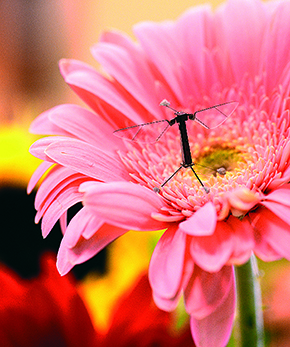
Harvard UniversityFlying like helicopters, micro-insects could assume the role of pollinatorsHarvard University
Unmanned aerial vehicles (UAVs), also known as drones, are gaining new sources of inspiration, according to the 14 articles published on the topic in a special issue of the journal Bioinspiration & Biomimetics in May 2014. In this case, the main sources of bioinspiration are insects and bats. The solutions presented by the researchers include using these flying minirobots for surveillance, research, search and rescue, and even pollination. Mini-drones have already been deployed in search and rescue operations and to investigate hazardous, hard-to-access areas in Fukushima, Japan, following the 2011 tsunami. Another study is focusing on the work of a team at Eötvös Loránd University, in Hungary, which has developed mathematical solutions (algorithms) that enable drones to fly in formation like a flock of birds. The researchers believe that the robots are capable of working as a team, and the algorithm’s effectiveness was demonstrated by having four drones successfully follow a moving car. At Harvard University, studies using flying microrobots just a few millimeters long and with rotary, helicopter-like wings have indicated their potential use in agricultural pollination, as well as supporting entomological research. The biggest problem for these flying insects is how to handle the forces of nature, such as heat, rain, and freezing cold.
Republish